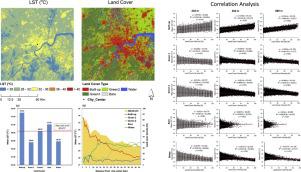当前位置:
X-MOL 学术
›
Urban Forestry Urban Green.
›
论文详情
Our official English website, www.x-mol.net, welcomes your feedback! (Note: you will need to create a separate account there.)
Detecting Cooling Effect of Landscape from Composition and Configuration: An Urban Heat Island Study on Hangzhou
Urban Forestry & Urban Greening ( IF 6.4 ) Pub Date : 2020-08-01 , DOI: 10.1016/j.ufug.2020.126719 Hao Hou , Ronald C. Estoque
Urban Forestry & Urban Greening ( IF 6.4 ) Pub Date : 2020-08-01 , DOI: 10.1016/j.ufug.2020.126719 Hao Hou , Ronald C. Estoque

|
Abstract Rapid urbanization, particularly in developing countries, is widely regarded as one of the most critical global issues in the 21 st century. It is known to exacerbate urban heat island effects, a phenomenon that could affect the livability of cities and the lives and comfort of more than half of the world population who are now living in urban areas. The issue on how to mitigate the impacts of this phenomenon and help urban dwellers adapt to it, has been, and continues to be, an important topic in the context of landscape design and urban planning. This study sought to examine the cooling effects of different land cover types from the perspectives of landscape composition and configuration using Landsat-8 OLI/TIRS data. Various spatial and statistical approaches, including urban-rural gradient, grid-based, landscape metrics, and scatter plot, were employed to analyze the derived land cover and land surface temperature (LST) maps. The results showed that both forest and water had a cooling effect during daytime in Hangzhou. The heat core in Hangzhou was situated close to the central business district and the variance in LST in urban and rural recorded at 3.22 ℃. The correlation of forest density with mean LST could be detected in both large (690 m) and small (210 m) grids, whereas the correlation of water density with mean LST was only observed in small grids. In general, forest with high aggregation and complex shape behave best in cooling LST while huge and complete water bodies had better cooling effect than scattered water patches. Besides, the minimum cooling scale of forest and water were proximately 120 m and 150 m from the cooling resources to the neighboring areas, respectively. The findings were considered valuable for urban planners to spatially and architecturally build and arrange the cooling land cover resources, eventually to fulfill the Chinese government’s new plan of building “livable cities”.
更新日期:2020-08-01



























 京公网安备 11010802027423号
京公网安备 11010802027423号